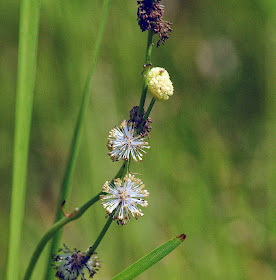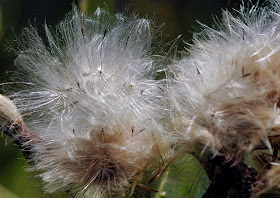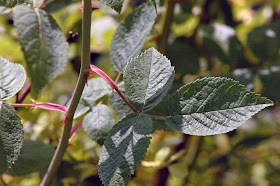Thanks to Tom Shisler for setting up a generator way back in the woods. With a full moon I knew it would not be productive out in the open. John Hickenbottom, naturalist at Lake Hope State Park spent the night as Tom's guest. John had never been on a moth walk. This is Orthosoma brunneum, the Brown Prionid Beetle. I'm always looking for more than just moths.
Back in the spring pools, this Long-tailed Salamander, Eurycea longicauda made an appearance late that night.
Tiger Spiketail, Cordulegaster erronea. Tom was doing a survey of dragonflies for a workshop with Bob Glotzhober the next day. Tigers are rare and endangered in Ohio. Unfortunately this one was on its last leg and didn't survive the day. The good news is Tom observed a half dozen different specimens on the area that day. They differ from other spiketails by the yellow rings around the abdomen. Yes I know the photo isn't great sitting on a piece of paper, but I had never seen one.
This small moth looks like a type of owlet, but has jagged wing margins like an inchworm. It holds its abdomen curled like a slug moth, and does push-ups with its front legs like several other micro moth families. What is it? Tosale oviplagalis, the Dimorphic Tosale. It is in the Pyralid family. The dark patch across the wing is diagnostic, but I like the raised tuft of scales above that mark that resembles a little bird wing.
Figure Seven Moth, Drasteria (Synedoida) grandirena.
It is often pictured in field guides with the Catacola moths because it could be mistaken for an Underwing Moth. Underwings have red, yellow, orange or white stripes in their hind wings. The hindwing here reminds me of a carved Jack O' Lantern. I do well on Rorschach tests.
What in the world? I can't tell if that's a vase on a stand, or Mr. Waternoose from Monsters Inc. Yes that is a moth outline.
Something this strange could only belong to my favorite group, the Slug Moths.
From the side you can see it really is a moth, in this case the Saddleback Slug, Acharia stimulea. Those weird tufts are raised scales on the legs and abdomen.
We are all familiar with the Saddleback caterpillar, but because of the lack of color, the adult is often overlooked. It has the 3-4 white spots on the wing like many other slugs. The chocolate color is highlighted up close by silvery-purple frosting. Sometimes they sit with their legs up and look like a spider. This male appears dead, flat, and squished, but he is very much alive.
Nason's Slug, Natada nasoni.
Button Slug, Tortricidia pallida, one of the smallest Limacodid slugs.
Smaller Parasa Slug, Parasa chloris. The night after Wahkeena, I went to see Lisa Sells at her new residence outside Lancaster, and we set up a sheet. If you know Lisa, you are aware that her macro photography is second to none. So this is a collection of photos from both locations.
Skiff Moth, Prolimacodes badia, another slug species. Have you noticed a sudden change in the photographs? I hate taking pics against a sheet. The background is terrible, and the bright light always messes with my results. After moths have settled into a sheet for a time, you can often move them to a more natural background. I am learning patience!
After a few pictures, the Skiff dropped off the leaf. It took me a minute to relocate it. I'd say it shows some pretty nice camouflage while on the ground.
In an up close view, you can see the waves of raised crinkly scales on the wings. The outline of the moth is broken up by various sized tufts of hairs from head to tail.
"Oh, that's one of those gray inchworms that all look alike." Yep, I have been guilty of saying that many times. I need to work on these inside, from specimens or photos. They are too difficult in the field. I've also
Ectropis crepuscularia, the Small Engrailed. There are many color varieties of this species, including this melanic form. The fore wings do not have stripes, but look streaked. Stripes are more visible on the hind wings. The upper abdominal segment is encircled with black. The outer fore wings have a zig-zag white line. All of these similar Geometrids show 3-4 small black dots at the top of the wing.
Here's another one. The 3-4 spots are more visible on the wing edges than the previous species. Many specimens will show more distinct stripes, but this one looks drab and dirty, with sort of a marble cake design, and lots of finely shredded chocolate chip drops. Stripes on the hind wing reach to the edge of the abdomen. Similar species have a large white ring on the first abdominal segment, which this lacks. I'm going with the Porcelain Gray, Protoboarmia porcelaria.
Let's end this post with some of the showier species. The Imperial Moth, Eacles imperialis.
Spiny Oakworm, Anisota stigma. This is the only one of the oak worms that shows a distinct pink line in both wings.
Elm Sphinx, Ceratomia amyntor. The caterpillar is known as the Four-horned Sphinx.
There were a lot of Catalpa trees in the area. Hmmm, how about the Catalpa Sphinx, Ceratomia catalpae. People use the caterpillars for fish bait. These are often confused with the Waved Sphinx. The Waved is clearly marked with white, black, and gray lines. Catalpa Sphinx moths are brown and gray, with faded or indistinct wing markings. Essentially, even when fresh, they look like a worn out Waved.
This one came out very nice. Purple and orange make quite a combination. Small-eyed Sphinx, Paonias myops, is one of the five sphinx moths with eye spots. It may have the least interesting eye spots on the hind wing compared to the others, but that fore wing pattern is hard to argue with.
Royal Walnut Moth, Citheronia regalis. This huge female had nearly a six inch wingspan. It's also known as the Regal Moth, and the larva is the Hickory Horned Devil.
Yellow-shouldered Slug Moth, Lithacodes fasciola. Now this is REAL macro photography! No it's not mine. Just wanted to show you the kind of stuff Lisa Sells has been working on.






+grandirena.jpg)































































